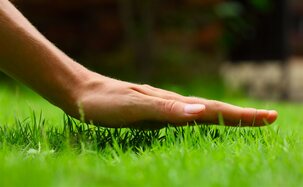 (BPT) - It’s been a rough winter in many parts of the country, but spring is here at last — and that means it’s time to give your lawn a bit of TLC. Although grass is highly resilient, you can help your lawn recover from winter and make sure it’s in top shape for summer with these tips from turfgrass researchers around the U.S. 1. Aerify to relieve soil compaction. If your lawn is old or heavily trafficked, or if it sat under wet snow for much of the winter, the soil may be compacted. Aerifying the turf with a core aerator (you can rent the equipment or hire a professional) can open up the soil, allowing water, nutrients and oxygen to reach the roots of the grass more easily. Aerification is recommended annually for cool-season lawns, but according to Clint Waltz, Ph.D., of the University of Georgia, a warm-season lawn that suffered drought-induced dormancy the previous summer can also benefit from aerification through mid-May. 2. Interseed for a thicker lawn. Lawns that are sparse or have worn patches can be interseeded when the soil warms up in the spring. Aaron Patton, Ph.D., of Purdue University said, “The earlier in the year that you seed, the more time the turf will have for root development before summer.” Be sure to use a high-quality seed that is a good match for your geographic region and your lawn’s soil type, sun exposure and irrigation patterns. 3. Watch your mowing height. Don’t wait too long to start mowing your lawn. Scalping an overgrown lawn causes stress that can affect the grass the rest of the season. As a rule of thumb, never cut more than one-third of the grass blade height at a time. Leaving the grass a bit taller can also improve the wear tolerance of the turf, said Geoffrey Rinehart of the University of Maryland. More leaf tissue allows the grass to better withstand foot traffic and protects the growing point at the base of the blade. 4. Grasscycle to feed your lawn naturally. You’ll probably want to remove the grass clippings the first few times you mow, to reduce shading, but once your lawn gets going, consider “grasscycling” — simply leaving the clippings on the lawn. Grady Miller, Ph.D., of North Carolina State University said, “Grass clippings decompose quickly and can provide up to 25 percent of the lawn’s fertilizer needs.” 5. Fertilize — but sparingly. Even if you’re grasscycling, you should fertilize your lawn at least twice a year (mid-May and mid-September work well in most areas). Cale Bigelow, Ph.D., of Purdue cautioned that the spring application should be sparing and should feature slow-release nitrogen fertilizer to minimize excess growth. Too much fertilizer can lead to rapid but weak growth, leaving your turf more susceptible to wear and stress. 6. Water properly. Proper irrigation in the spring can help prevent or reduce pest problems and environmental stress later in the summer, said Miller. He recommended watering to a soil depth of 4 to 6 inches. (You can check the depth by pushing a screwdriver into the soil. If it goes in easily, the soil likely has enough moisture.) Watering deeply once or twice a week is better than frequent light watering. 7. Take it easy. Moss, mushrooms and other lawn pests may make an appearance in early spring, but once your grass comes out of dormancy and begins growing quickly in late spring, the hardy turfgrass will push many of these invaders out. Issues will often resolve themselves if you create the conditions that favor the grass. If infestations recur, your county extension agency can help you identify the underlying problem and provide recommendations that are specific to your region and type of grass. A little spring maintenance can pay off big later in the year. If you want healthy, wear-resistant turf for the high-traffic summer season, now is the time to start setting your lawn up for success. Learn more about quick, easy lawn improvement and maintenance tips from the experts at Grass Seed USA, a coalition of grass seed farmers and academic turf specialists, at www.WeSeedAmerica.com or follow @WeSeedAmerica on Facebook and Twitter. Categories
0 Comments
Your comment will be posted after it is approved.
Leave a Reply. |
Salt Spray ShedsDownload our free garden shed plans for the sun and shade here Archives
May 2024
Categories
All
|
|
© Salt Spray Sheds 1994-2024 · Family Owned and Operated Building Post and Beam Accessory Buildings, Year Round, at Your Property 235 Great Western Rd, S. Dennis, MA 02660 Office Hours M - F 10 am to 2 pm. The office will be closed Wednesday, May 15 through Friday, May 17 We look forward to seeing you on Tuesday, May 21 Please leave a message with our service or email us. Phone 508-398-1900 The office is experiencing higher than normal call volume and office appointments, we encourage you to email us for a quote or questions. *Please note, the office is closed on all federal holidays. |
We encourage contacting us via email for quotes
Email [email protected] |


 RSS Feed
RSS Feed